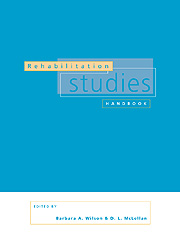Book contents
- Frontmatter
- Contents
- List of contributors
- 1 Introduction to rehabilitation
- 2 Disabled people in society
- 3 Disability equality training
- 4 Towards a therapeutic alliance model of rehabilitation
- 5 Rehabilitation education: a learner-centred approach
- 6 Work, occupation and disability
- 7 Management in rehabilitation
- 8 Research and evaluation in rehabilitation
- 9 Statistical methods
- 10 Social policy, disability and rehabilitation
- 11 Principles of the acquisition of sensorimotor skills
- 12 Management of acquired cognitive disorders
- 13 Challenging behaviour: helping people with severe brain damage
- 14 Pain
- 15 The multiply handicapped child
- 16 The transition to adult life
- 17 Factors specific to disabled elderly people
- Index
13 - Challenging behaviour: helping people with severe brain damage
Published online by Cambridge University Press: 06 November 2009
- Frontmatter
- Contents
- List of contributors
- 1 Introduction to rehabilitation
- 2 Disabled people in society
- 3 Disability equality training
- 4 Towards a therapeutic alliance model of rehabilitation
- 5 Rehabilitation education: a learner-centred approach
- 6 Work, occupation and disability
- 7 Management in rehabilitation
- 8 Research and evaluation in rehabilitation
- 9 Statistical methods
- 10 Social policy, disability and rehabilitation
- 11 Principles of the acquisition of sensorimotor skills
- 12 Management of acquired cognitive disorders
- 13 Challenging behaviour: helping people with severe brain damage
- 14 Pain
- 15 The multiply handicapped child
- 16 The transition to adult life
- 17 Factors specific to disabled elderly people
- Index
Summary
Introduction
Roget's Thesaurus mentions-the following in association with ‘behaviour’: posture, appearance, motion, action, gesticulation, gesture, manner, habit, line of action, tactics, manoeuvre, behave towards, treat, deal with, manage. This all sounds very physical as well it might because when we talk of studying or changing animal behaviour, we are focusing on the things on which natural sciences focus attention, the physical world of matter.
An animal is a physical thing that can be studied like other physical things. We can try to detect events in various modalities, for example, can we see it move and if so, what can we see it do, what changes does it bring to its environment? For example, does it move things about, perhaps throw things? Also the modality of sound, does it growl, can you infer that it is striking something by the sounds that you hear? If it belongs to a gregarious species, what effect does its behaviour have on other members who are nearby? Other animals are part of the physical environment as well as inanimate things but, within a gregarious species, we may then call other animals the social environment.
When psychologists use the behavioural model, problems or issues are operationalised in a similar way to the procedures of other natural sciences. Animal behaviour becomes matter in motion and these phenomena are counted in units that are standard and absolute. Combinations of these basic units can be combined to describe additional more complex phenomena (Hersen & Bellack, 1981).
It should be emphasised that models are theoretical constructs, i.e. they are systematic ways of thinking about, describing and formulating issues.
- Type
- Chapter
- Information
- Rehabilitation Studies Handbook , pp. 263 - 288Publisher: Cambridge University PressPrint publication year: 1997



